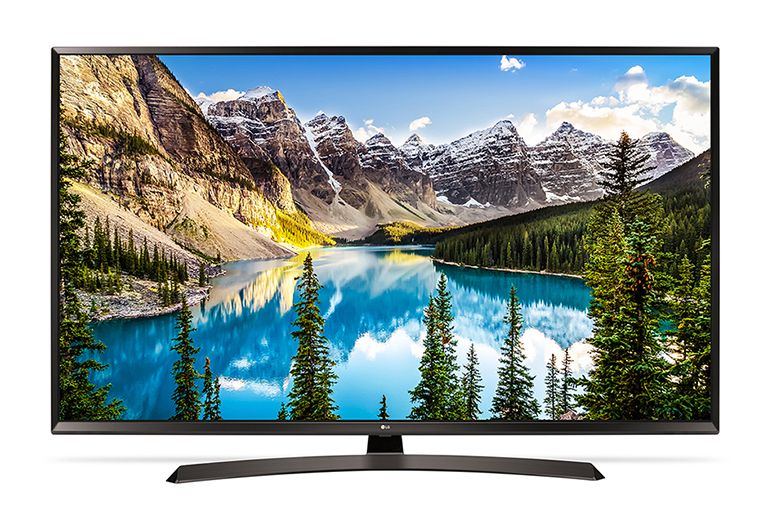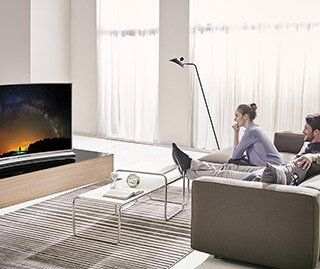How to choose a TV according to the size of the room
 When choosing a TV, many buyers think that the larger its size, the better and clearer the broadcast image will be. However, a completely different characteristic is responsible for quality. At the same time, many people forget that the wrong device can look awkward in the room and also cause some discomfort when viewing. For example, a large TV will look extremely bad in a small room. Therefore, when purchasing, you must first take into account the area of the room in which the TV receiver will be placed.
When choosing a TV, many buyers think that the larger its size, the better and clearer the broadcast image will be. However, a completely different characteristic is responsible for quality. At the same time, many people forget that the wrong device can look awkward in the room and also cause some discomfort when viewing. For example, a large TV will look extremely bad in a small room. Therefore, when purchasing, you must first take into account the area of the room in which the TV receiver will be placed.
The content of the article
How to choose a TV based on the size of the room
According to international measurement standards, the diagonal of a TV is always indicated in inches, which confuses some buyers.

REFERENCE! Diagonal is the distance between two opposite corners of the TV. The most common sizes are from 19 to 58 inches, which is approximately 48 to 147 cm.
The size of the diagonal, as well as the presence of additional functions, will affect the final cost.
When choosing a diagonal, you need to focus on the size of the room. As a rule, this is quite difficult to do visually in stores due to the large retail space. To make the task easier, you can measure the model you like with a tape measure and, when you get home, mark the resulting dimensions in the place where you plan to put the purchase.
After which you need to take a few steps back. The optimal distance is about three steps. This method will greatly facilitate the choice and help estimate the actual size of the TV in a living space. Don't forget about the location. For example, when placed in the kitchen, the usual standards are not suitable.
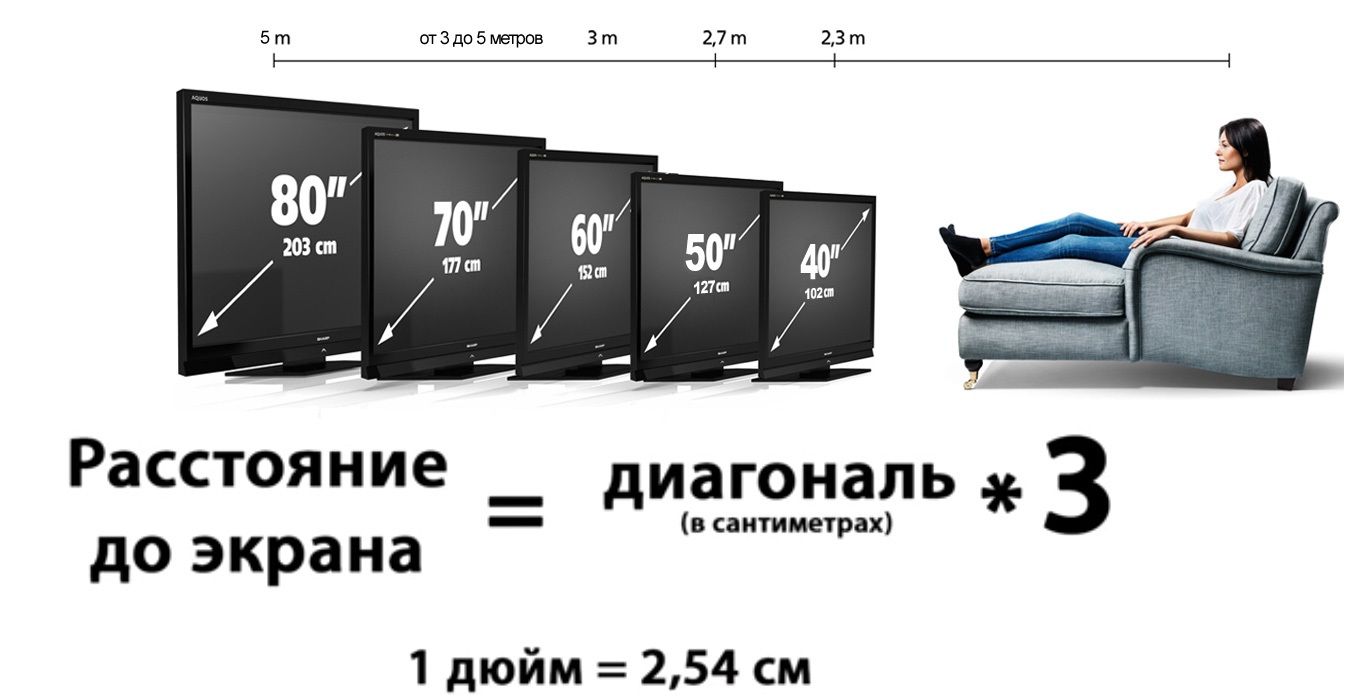
Many people confuse the actual size of a TV receiver and its diagonal. The size also takes into account the frame, while the diagonal is calculated only from the matrix. Its size itself is indicated in the name of the model, these are the first two digits. It does not affect image quality. Responsible for picture quality:
- screen format - 16:9, 4:3;
- what is the resolution of the matrix - 1366 x 768, 1920 x 1080, etc.;
- contrast value - number of gigahertz;
- the quality of the matrix itself.
REFERENCE! Now many manufacturers produce models with OLED technologies. Thanks to it, it became possible to achieve the best contrast, which is not lost even in dynamic scenes. It is absolutely safe for the eyes, which allows you to purchase a large TV. However, the cost of such models is significantly higher than LED and plasma screen.
Optimal correspondence between distance and diagonal: table
In order to select the required diagonal quickly and easily, the experts compiled a small table-memo. Using it, you can choose the right size without any problems. After all, with the right choice, the TV will not cause eye strain.
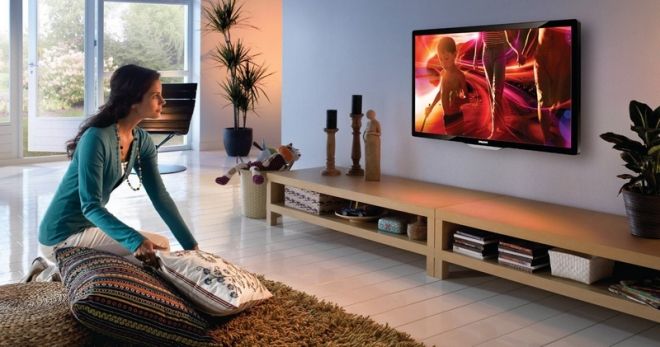
IMPORTANT! If the size is too large for the area of the room, the human eye cannot take in the entire picture, which can cause vision problems.
The data obtained during the calculation are considered approximate with an error of about half a meter. It is also necessary to take into account the place where the TV will be placed, because it can be mounted using a special bracket on the wall.
Table: ratio of optimal distance and diagonal

ATTENTION! In small rooms, it is recommended to place the TV on the wall.
How are TV diagonal and resolution related?
The optimal distance for placing a TV from your favorite sofa depends not only on the diagonal size, but also on the resolution of the matrix. Screen resolution directly affects the quality of the broadcast image. As a rule, TVs use matrices with the following resolution:
- HD Ready - 1366x768.
- Full HD - 1920x1080.
- Ultra HD - 3840x2160.
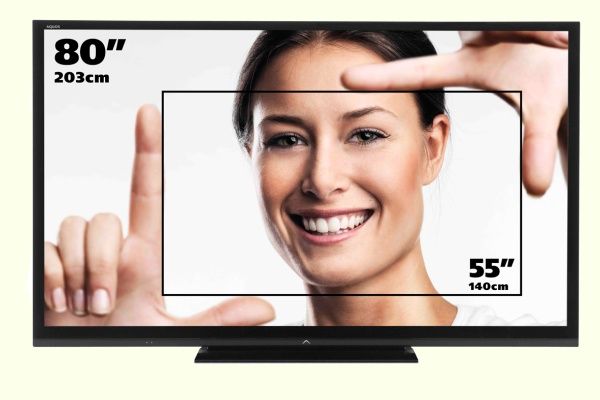
These numbers indicate the number of pixels. There is also a 4K resolution, which is several times higher than Full HD and the number of pixels is about 8 million. Thus, the greater the number of pixels, the clearer the transmitted image will be. In this case, the optimal distance will be smaller. That is, TV receivers with a higher screen resolution can be viewed from a shorter distance.
For example, a TV with a diagonal of 32 inches and a resolution of 625 pixels must be viewed from a distance of about 2.5 meters, and if the resolution is already 720, then one and a half meters will be enough. It is worth adding that high resolution is realized on devices with a diagonal of 40 inches or more. And the smaller the diagonal, the less noticeable the difference in resolution.
When buying a TV, you should focus on several parameters: room size, screen resolution, availability of functions. After all, each of the indicators affects the cost and ease of viewing.



